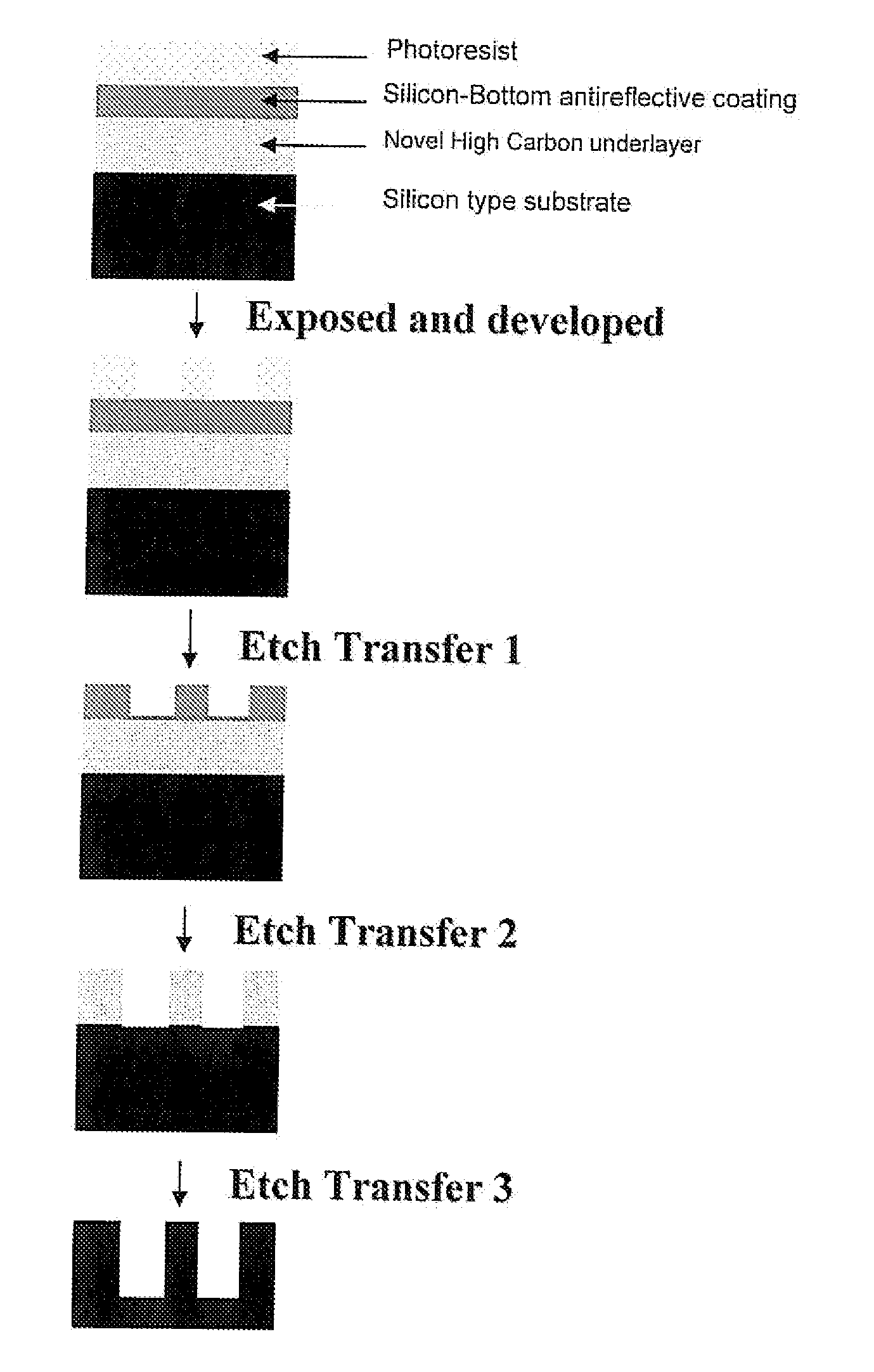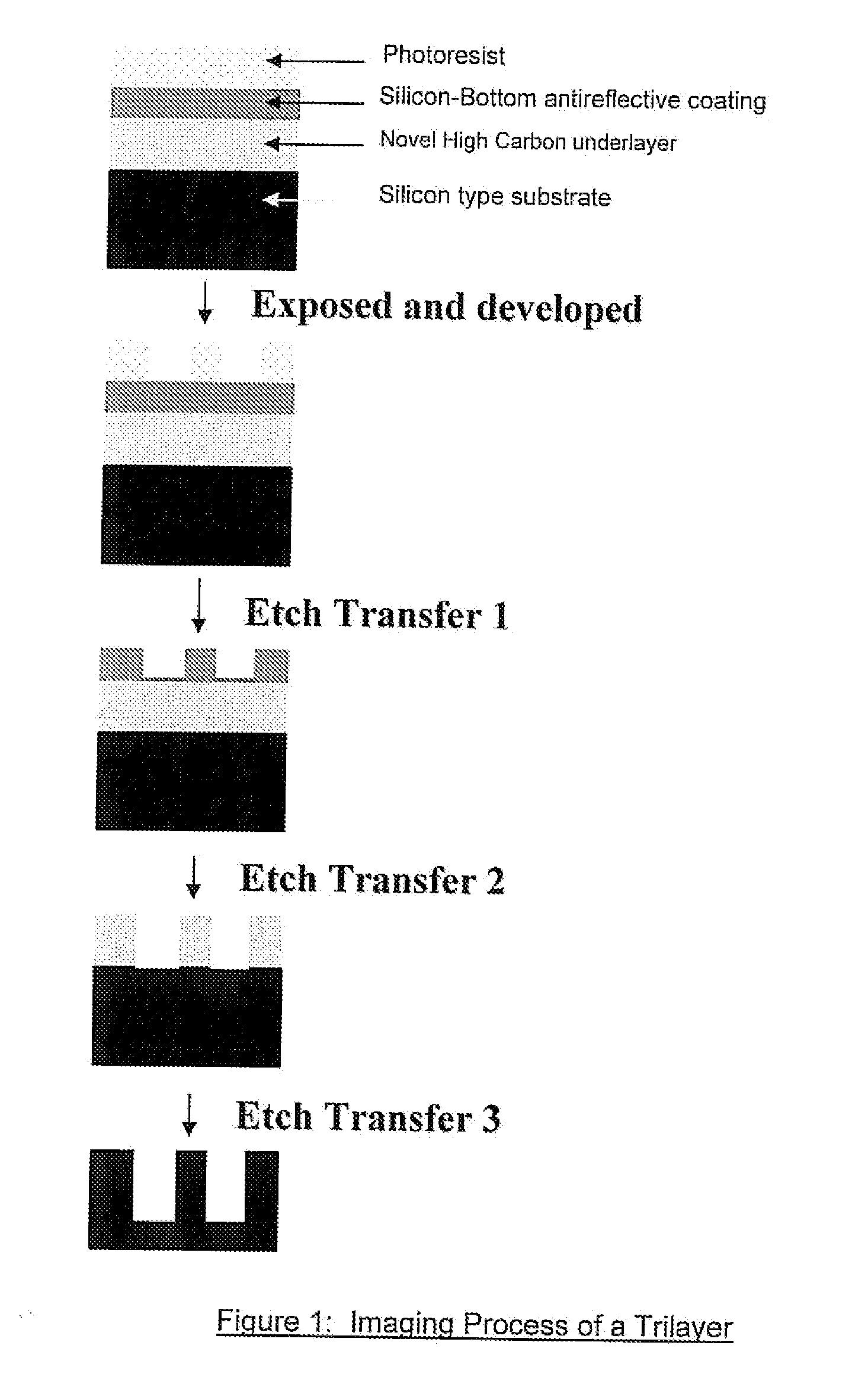Antireflective Coating Composition and Process Thereof
a technology of coating composition and anti-reflective coating, applied in the direction of photosensitive materials, instruments, photomechanical equipment, etc., can solve the problems of back reflectivity, thin film interference effect and reflective notching, and change in critical line width dimensions
- Summary
- Abstract
- Description
- Claims
- Application Information
AI Technical Summary
Benefits of technology
Problems solved by technology
Method used
Image
Examples
example 1
[0045]9-Anthracenemethanol (52.06 g˜0.25 mole), divinylbenzene (16.3 g˜0.125 mole), were taken in a 2 Liter four neck round bottom flask, equipped with a stirrer, condenser, Thermo watch and nitrogen sweep. 213 g of di(ethyleneglycol)dimethylether (diglyme), and 60 g of cyclopentyl methyl ether (CPME) was added and mixed for 10 minutes under nitrogen. 2.05 g of trifluoromethane sulphonic acid was added and mixed for 10 minutes. The flask was heated to 140° C. and refluxed for three hours. After the reaction, the flask was cooled and 500 ml CPME added. The reaction mixture was transferred to 5 L flask with a bottom outlet valve. 300 mL deionized (DI) water was added, mixed and allowed to settle to form a separate water layer. The polymer solution was mixed with 5 L hexane. The precipitate was filtered, washed with hexane and dried under vacuum. The crude polymer (46.0 g) was dissolved in tetrahydrofuran (THF) (400 ml). The solution was added to 4 liters of hexane and a precipitate wa...
example 2
[0046]7.0 g of the polymer from Example 1, 0.70 g of tetramethoxymethyl-bisphenol (TMOM-BP), 2.80 g of dodecylbenzenesulphonic acid with triethyl amine as a salt at 10% solution in cyclohexanone / PGMEA (70 / 30) and 89.5 g of cyclohexanone / PGMEA (70 / 30) were mixed. After complete mixing the formulation was filtered through a 0.04 μm filter.
example 3
[0047]This filtered solution from Example 2 was spin-coated on an 8″ silicon wafer at 1500 rpm. The coated wafer was baked on a hotplate at 230° C. for 60 seconds. The thin coated material was scraped out from the wafer surface by a blade and elemental analysis was done. The results are shown in the Table 1. Another silicon wafer was spin-coated with the filtered solution from Example 2 at 1500 rpm and the coated wafer was baked at 400° C. for 120 seconds. The baked material was scraped out from the wafer surface by a blade and elemental analysis was done. The results are shown in the Table 1.
TABLE 1Composition from Example 2CarbonHydrogenOxygen(%)(%)(%)Bake at 230° C. for 60 seconds91.526.032.45Bake at 400° C. for 120 seconds83.413.4813.11
PUM
| Property | Measurement | Unit |
|---|---|---|
| Percent by mass | aaaaa | aaaaa |
| Nanoscale particle size | aaaaa | aaaaa |
| Nanoscale particle size | aaaaa | aaaaa |
Abstract
Description
Claims
Application Information
 Login to View More
Login to View More - R&D
- Intellectual Property
- Life Sciences
- Materials
- Tech Scout
- Unparalleled Data Quality
- Higher Quality Content
- 60% Fewer Hallucinations
Browse by: Latest US Patents, China's latest patents, Technical Efficacy Thesaurus, Application Domain, Technology Topic, Popular Technical Reports.
© 2025 PatSnap. All rights reserved.Legal|Privacy policy|Modern Slavery Act Transparency Statement|Sitemap|About US| Contact US: help@patsnap.com



